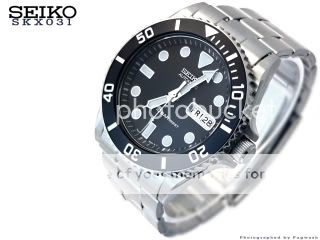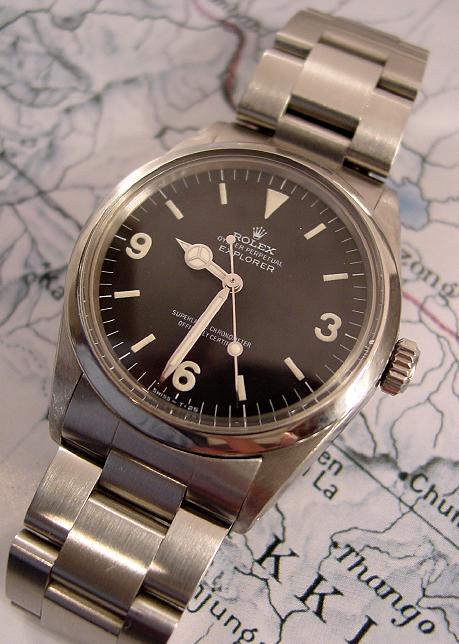The best values in watches today are produced by Japan's Big Three: Casio, Citizen and Seiko. Casio never strays far from its special niche, digital watches, and stays in the bottom end of the consumer market. Citizen and Seiko produce far more diverse product ranges, in terms both of style and price. I pay a lot of attention to these two companies, as do all affordable watch enthusiasts. They produce a lot of interesting watches at great prices.
I would introduce you here to six Seiko diving watches (divers). All are currently in production and are among the more popular entry to upper-mid level models. Note that the Seiko SKX031 is not an ISO-rated dive watch. Many would consider it, strictly speaking, a sports watch with diver styling. But this is not of practical importance to most owners, who will use them only for "desk diving." Most divers prefer dive computers over simple diving watches.
Seiko SKX007 200m Professional Diver

Seiko SKX031 “Submariner”

Seiko SKX779/781 "Black/Orange Monster"

Seiko SBDA001/SNM011 "Samurai"

Seiko SBDC001 "Sumo"
Bonus: See now the review by Quartzimodo of the new sports versions of the Black/Orange Monster, which offer several variations of the Monster in a 100m sports watch.
Addendum [12/01/2010]: The Seiko SKX031 has apparently gone out of production. There are still some remaining in stock at a number of vendors, but prices have gone up. For smaller Seiko divers, there remains the SKX013, a 38mm version of the SKX007, and the SKX023, which is identical to SKX031 but 2mm smaller in diameter (38mm).
I would introduce you here to six Seiko diving watches (divers). All are currently in production and are among the more popular entry to upper-mid level models. Note that the Seiko SKX031 is not an ISO-rated dive watch. Many would consider it, strictly speaking, a sports watch with diver styling. But this is not of practical importance to most owners, who will use them only for "desk diving." Most divers prefer dive computers over simple diving watches.
Seiko SKX007 200m Professional Diver

Seiko SKX031 “Submariner”

Seiko SKX779/781 "Black/Orange Monster"

Seiko SBDA001/SNM011 "Samurai"
- Dan's Watch Collection
- Quartzimodo's Time Journal
- Seiko and Citizen Watch Forum (Andy)
- MinuteMachines [art photos]

Seiko SBDC001 "Sumo"
Bonus: See now the review by Quartzimodo of the new sports versions of the Black/Orange Monster, which offer several variations of the Monster in a 100m sports watch.
Addendum [12/01/2010]: The Seiko SKX031 has apparently gone out of production. There are still some remaining in stock at a number of vendors, but prices have gone up. For smaller Seiko divers, there remains the SKX013, a 38mm version of the SKX007, and the SKX023, which is identical to SKX031 but 2mm smaller in diameter (38mm).

 The Hamilton Pulsar P2 2900 LED watch in "Live and Let Die" (1973) was an understandable expression of high-tech enthusiasm, but all the Seikos of the 70s and 80s were just lucrative product placements. And all of the gadget watches, and Bond's spy gadgets generally, have been very appropriately satirized. Admit it—both the movies and the gadgets could get really silly. (Statement of disclosure: This Bond fan refuses to recognize any Bond movies not starring Connery or Craig. Well, there may be a couple of exceptions.)
The Hamilton Pulsar P2 2900 LED watch in "Live and Let Die" (1973) was an understandable expression of high-tech enthusiasm, but all the Seikos of the 70s and 80s were just lucrative product placements. And all of the gadget watches, and Bond's spy gadgets generally, have been very appropriately satirized. Admit it—both the movies and the gadgets could get really silly. (Statement of disclosure: This Bond fan refuses to recognize any Bond movies not starring Connery or Craig. Well, there may be a couple of exceptions.) But the primeval and archetypal Bond watch was merely a functional timekeeper. It is described specifically in Ian Fleming's books as a “Rolex Oyster Perpetual Chronometer on an expanding metal bracelet.” So it was a Rolex. But the rest of that description does not pin down a precise model. One watch enthusiast has recently
But the primeval and archetypal Bond watch was merely a functional timekeeper. It is described specifically in Ian Fleming's books as a “Rolex Oyster Perpetual Chronometer on an expanding metal bracelet.” So it was a Rolex. But the rest of that description does not pin down a precise model. One watch enthusiast has recently  But this is not the Bond Rolex as everyone knows it. From the very first movie ("Dr. No" [1962]) Bond wears a Rolex Ref. 6538 or 5508, commonly called the Rolex Submariner. It is a professional diver's watch, really the first, depth rated for 200m. It came on a stainless steel bracelet, like most Rolexes, but in the first two Bond movies Connery wore it on a leather strap. That watch was actually the personal Rolex of director
But this is not the Bond Rolex as everyone knows it. From the very first movie ("Dr. No" [1962]) Bond wears a Rolex Ref. 6538 or 5508, commonly called the Rolex Submariner. It is a professional diver's watch, really the first, depth rated for 200m. It came on a stainless steel bracelet, like most Rolexes, but in the first two Bond movies Connery wore it on a leather strap. That watch was actually the personal Rolex of director 















